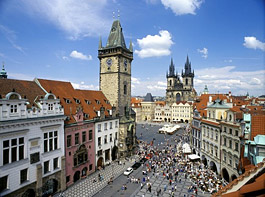
Prague is preparing a new regulation on building codes
 |
"The current regulation addresses problems of the city from the 19th century and does not tackle the problems of the 21st-century city," summarized the reason for the change by project coordinator Pavel Hnilička from the Institute of Planning and Development of the Capital City of Prague (IPR). According to him, around 30 people have been working on the proposal for about two years. They have conducted analyses of the current state and have also looked to the situations in Vienna, Munich, and Amsterdam for inspiration. He claims they collaborated with experts from various professions while working on the actual regulation.
According to the authors, the new building codes define "general requirements for land use and technical requirements for buildings in Prague," address contemporary problems of the city, and respond to undesirable phenomena in its functioning. They are said to focus on urban relationships that have been neglected until now. "It is based on the awareness that buildings are not mere solitaires, but rather co-create the image of the city," the authors stated on the IPR website.
The municipal departments have already commented on the amendment to the regulation, and city districts can send their remarks until February 18. Some of them do not hide their skepticism. For example, the council of Prague 1, according to mayor Oldřich Lomecký (TOP 09), approved a list of numerous comments. "In terms of professionalism, it is at a very high level. However, the council disagrees with many points," Lomecký told reporters.
He criticizes, for example, the lower parking coefficients, the effort to allocate part of the roadways for cyclists, or the fact that the proposal lacks a list of places where advertising should not be allowed. Similar remarks were made by the deputy mayor of Prague 9, Tomáš Portlík (ODS). According to him, the proposal makes no mention of education, and the reduced coefficients will cause enormous problems with parking. Prague 6 has also expressed its disapproval of the proposal, claiming that, for example, it will allow more construction in flood-prone areas based on the regulation.
Deputy mayor of Prague 2 Václav Vondrášek (ODS) joined the criticism, stating that the proposal "loosens any regulations" and is complicated, as did the chairman of the Prague ODS Filip Humplík (ODS), who claimed that the regulation brings chaos. He described it as a blank check for builders and urban planners. "As a result, Prague will become a permanent construction site for the next several decades," he told ČTK.
Hnilička defends against the criticism, seeing political motivation behind it against mayor Tomáš Hudeček (TOP 09), who initiated its preparation. According to him, the slight reduction in parking coefficients in the center arises from an effort to limit the number of cars. "We start from the premise that the more space is given to cars, the more of them there will be in the center," he remarked, indicating that this is a trend seen in large cities in Western Europe. "Concrete figures can be debated; we are ready to discuss this," he added. His stance on cycling is similar.
He completely rejects the notion that the proposal would allow the return of advertising to the center. According to him, the document proposes two solutions. The first would ban all advertising over six square meters in the city area, the second over 15 square meters. Most of the opinions he has recorded so far lean towards the first, significantly stricter option.
The English translation is powered by AI tool. Switch to Czech to view the original text source.
0 comments
add comment












